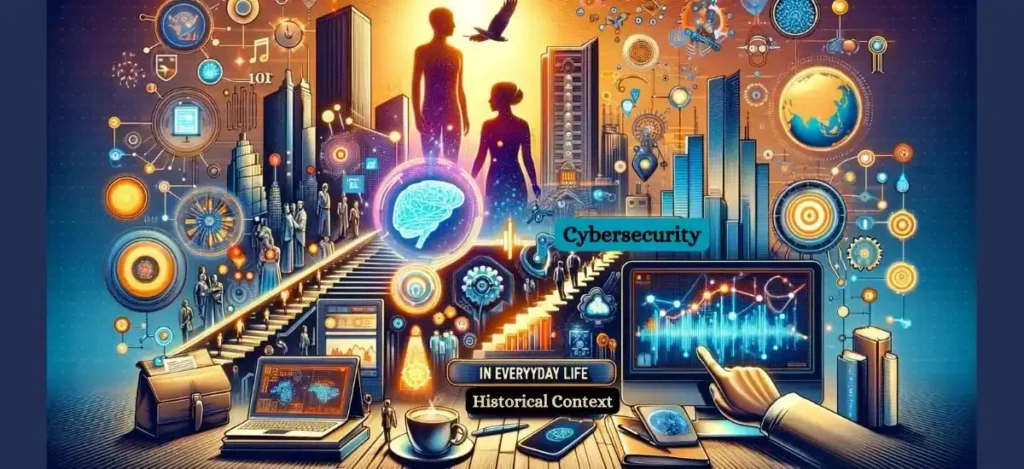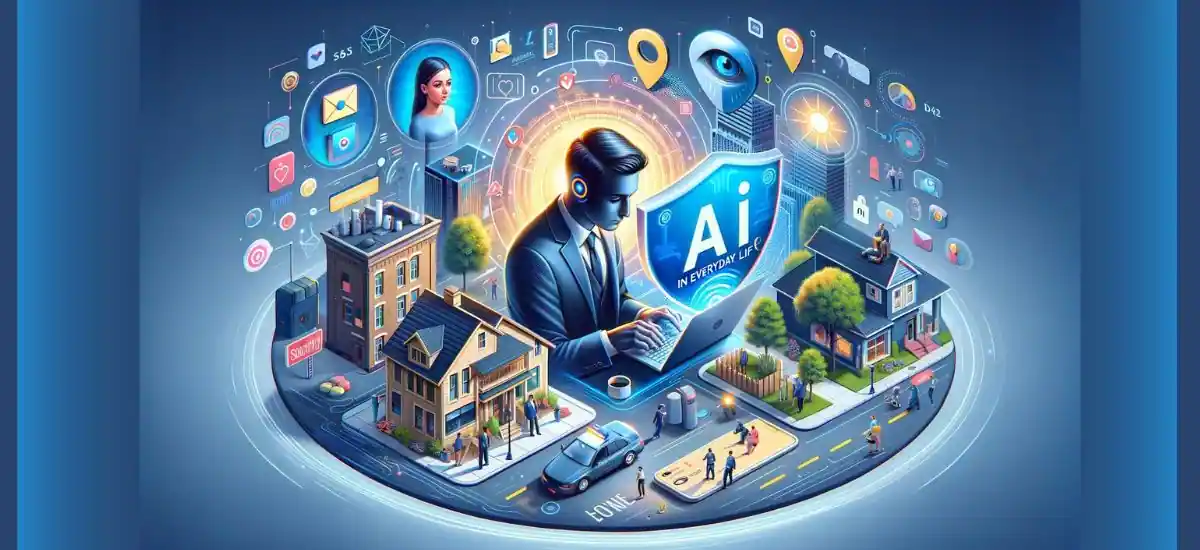AI in Everyday Life: From Sci-Fi to Reality” explores the transformative impact of artificial intelligence (AI) on our daily lives. Once relegated to the realm of science fiction, AI technologies have rapidly evolved and become ubiquitous in modern society. From virtual assistants and recommendation algorithms to autonomous vehicles and healthcare diagnostics, AI permeates various aspects of our everyday routines.
In this comprehensive exploration, we delve into the evolution of AI, its practical applications across diverse industries, and the ethical considerations that accompany its widespread adoption. Join us on a journey from imagination to implementation as we navigate the intersection of AI and everyday life
Historical Context

1. The Cybersecurity Journey
- From Simple Beginnings: We’ll start by looking at how cybersecurity was in the early days – think basic passwords and simple firewalls, kind of like using a basic lock on your front door.
- Evolving Threats: As technology got more complex, so did the threats. We’ll talk about how the bad guys’ tactics have changed over time, forcing cybersecurity to level up.
- Raising the Bar: Here, we’ll see how the need for stronger defenses led to more sophisticated security measures – it’s like upgrading from a simple lock to a high-tech security system for your home.
2. The Emergence Of AI In Cybersecurity
- A New Player Enters: This is where AI comes into the picture. We’ll chat about how and why AI started to be seen as a potential game-changer in fighting cyber threats.
- Early Days of AI in Security: Think of this as AI’s first steps – not quite a superhero yet, but showing a lot of promise in spotting and dealing with cyber threats.
- Growing Pains and Triumphs: Every new tech has its ups and downs. We’ll explore some early successes and challenges faced by AI in cybersecurity.
3. Key Milestones In AI-Driven Cybersecurity Solutions
- Breakthrough Moments: Here, we’ll highlight some big wins where AI really proved its worth in cybersecurity, like stopping a major attack or outsmarting a new kind of threat.
- Learning and Adapting: AI’s ability to learn from past incidents has been a game-changer. We’ll discuss how this learning process has strengthened cybersecurity over time.
- Setting New Standards: Finally, we’ll talk about how AI has not just improved existing security measures but also introduced entirely new ways of protecting our digital world.
AI Technologies In Cybersecurity
1. Machine Learning And Pattern Recognition
- Learning from Experience: Just like you learn from your mistakes, AI uses machine learning to get smarter about cybersecurity from past data. It’s like having a student who never forgets a lesson.
- Spotting the Odd One Out: AI is great at noticing when something doesn’t fit the pattern, like a piece of a puzzle that doesn’t belong. This helps in identifying threats that might otherwise slip through the cracks.
2. Natural Language Processing For Threat Intelligence
- Understanding Human Talk: AI uses Natural Language Processing (NLP) to read and understand human language. It’s like having a bookworm that reads all the internet chatter to pick up on potential threats.
- Staying Informed: By analyzing news, blogs, and online forums, AI keeps up with the latest cybersecurity trends and hacker tactics, always staying one step ahead.
3. Predictive Analytics For Identifying Potential Threats
- Playing Fortune Teller: AI uses predictive analytics to forecast potential security incidents. It’s like having a crystal ball, but for predicting cyber attacks.
- Learning from Patterns: By studying patterns of past attacks, AI predicts where future threats might come from, helping to prepare and prevent them before they happen.
4. AI In Vulnerability Management
- Finding the Weak Spots: AI scans systems to find weak points, like a doctor checking for health issues. It’s always on the lookout for vulnerabilities that could be exploited.
- Prioritizing Risks: Not all security weaknesses are equally dangerous. AI helps prioritize which vulnerabilities need immediate attention, kind of like triaging patients in a hospital.
Applications Of AI In Cybersecurity
1. Automated Threat Detection And Response
- Always on Guard: AI is like a vigilant guard, constantly scanning for cyber threats. It’s like having an eagle-eyed watchman who never sleeps, always keeping an eye out for danger.
- Quick Action: Upon detecting a threat, AI doesn’t just alert us; it actively works to neutralize it. This is akin to having a firefighter on standby, ready to extinguish fires the moment they flare up.
- Round-the-Clock Protection: This system works 24/7, ensuring continuous security. It’s like a tireless shield, always up and running to protect our digital assets.
2. AI In Fraud Detection And Prevention
- Spotting the Scams: AI looks for unusual patterns that could indicate fraud, like strange transactions. It’s like a detective piecing together clues to catch a criminal.
- Real-Time Alerts: If something suspicious pops up, AI quickly lets us know. This rapid response is crucial in preventing fraud before it can do real damage.
- Learning from Transactions: Over time, AI gets better at understanding what normal activity looks like for each user, improving its accuracy. It’s like a smart assistant that learns your habits to serve you better.
3. Enhancing Network Security With AI
- Monitoring Traffic: AI keeps an eye on data flowing in and out of networks, looking for anomalies. It’s like having a traffic cop on the data highway, ensuring everything flows smoothly and safely.
- Adaptive Defenses: It adjusts security measures based on the level of threat detected. This flexibility is like a chameleon changing colors to blend in and protect itself.
- Preventing Unauthorized Access: AI helps in identifying and blocking potential intrusions before they cause harm. It acts as a gatekeeper, deciding who gets in and who doesn’t.
4. AI In Identity And Access Management
- Verifying Identities: AI checks if the person trying to access information is really who they claim to be. It’s like a bouncer checking IDs at the door.
- Behavior Analysis: It learns users’ typical online behaviors to identify imposters. This is similar to a detective noticing out-of-place behavior in a crowd.
- Enhanced Security Measures: AI can require additional verification if it detects unusual login attempts. It’s like adding an extra lock on your door when you know the risks are high.
Benefits Of AI In Cybersecurity

1. Faster, Smarter, Stronger Detection
- Real-Time Monitoring: AI systems are like vigilant sentinels, constantly scanning the digital landscape. They can process vast amounts of data in real time, much faster than a human team could. This means they can identify threats the moment they appear, from suspicious network patterns to unusual user behavior.
- Learning from Experience: Every time AI encounters a new type of threat, it learns. This learning process makes AI systems increasingly effective. They’re not just following a script; they’re adapting based on new information, much like a detective who gets better with every case they solve.
2. Quick Response Team
- Automated Responses: When AI detects a threat, it can automatically take action to mitigate it. This might mean isolating a compromised network segment, blocking a suspicious IP address, or initiating a security protocol. This immediate action can be the difference between a minor security incident and a major breach.
- Supporting Human Teams: AI doesn’t just work alone; it’s a tool that enhances the capabilities of human cybersecurity teams. By handling routine and immediate threats, AI frees up human experts to focus on more complex and strategic security tasks.
3. No More Crying Wolf
- Reducing False Positives: One of the biggest challenges in cybersecurity is the high rate of false positives – alerts that turn out to be harmless. AI improves the accuracy of threat detection, which means fewer false alarms. This precision saves time and resources and reduces the risk of overlooking actual threats amidst numerous false alerts.
- Contextual Understanding: AI systems can understand the context of a security alert. They can analyze whether an action is genuinely suspicious or just a deviation from normal but harmless behavior. This context-sensitive analysis is crucial in a landscape where threats are constantly evolving.
4. Staying Ahead Of The Curve
- Adapting to New Threats: Cyber threats are always evolving, but so is AI. With machine learning, AI systems continuously update their understanding of what constitutes a threat. This adaptability is key in a field where yesterday’s solutions might not work on today’s problems.
- Predictive Capabilities: AI can predict future threats based on current trends. This predictive power means organizations can prepare and protect themselves against threats that haven’t even emerged yet. It’s like having a weather forecast for cybersecurity, allowing for proactive defense measures.
Frequently Asked Questions
Q1. How does AI adapt to the constantly evolving nature of cyber threats?
Answer: AI continuously learns from new data on cyber threats, adapting its strategies to stay ahead of hackers.
Q2. Can AI in cybersecurity replace human security experts?
Answer: No, AI assists with repetitive tasks and data analysis, but human expertise is essential for complex decision-making.
Q3. What role does AI play in personal cybersecurity?
Answer: AI helps protect personal devices from threats like hacking and phishing, acting as a digital guard for home technology.
Q4. How does AI help in responding to a cybersecurity incident?
Answer: AI quickly analyzes cyber incidents, helps contain breaches, and assists in recovery by identifying attack sources and prevention strategies.
Read More:

